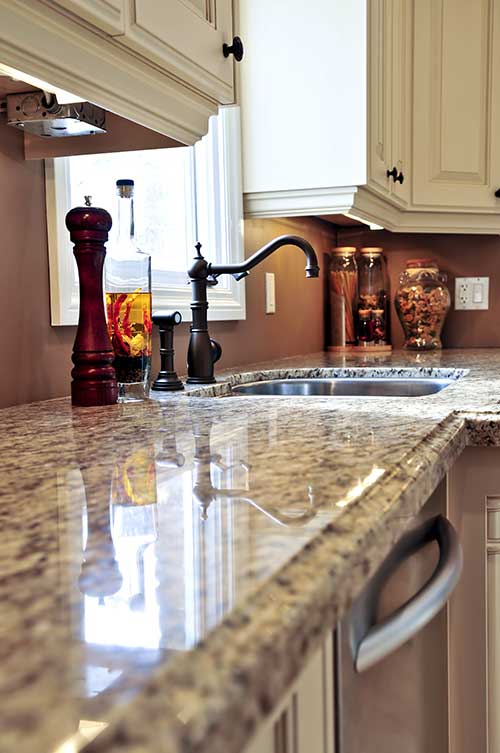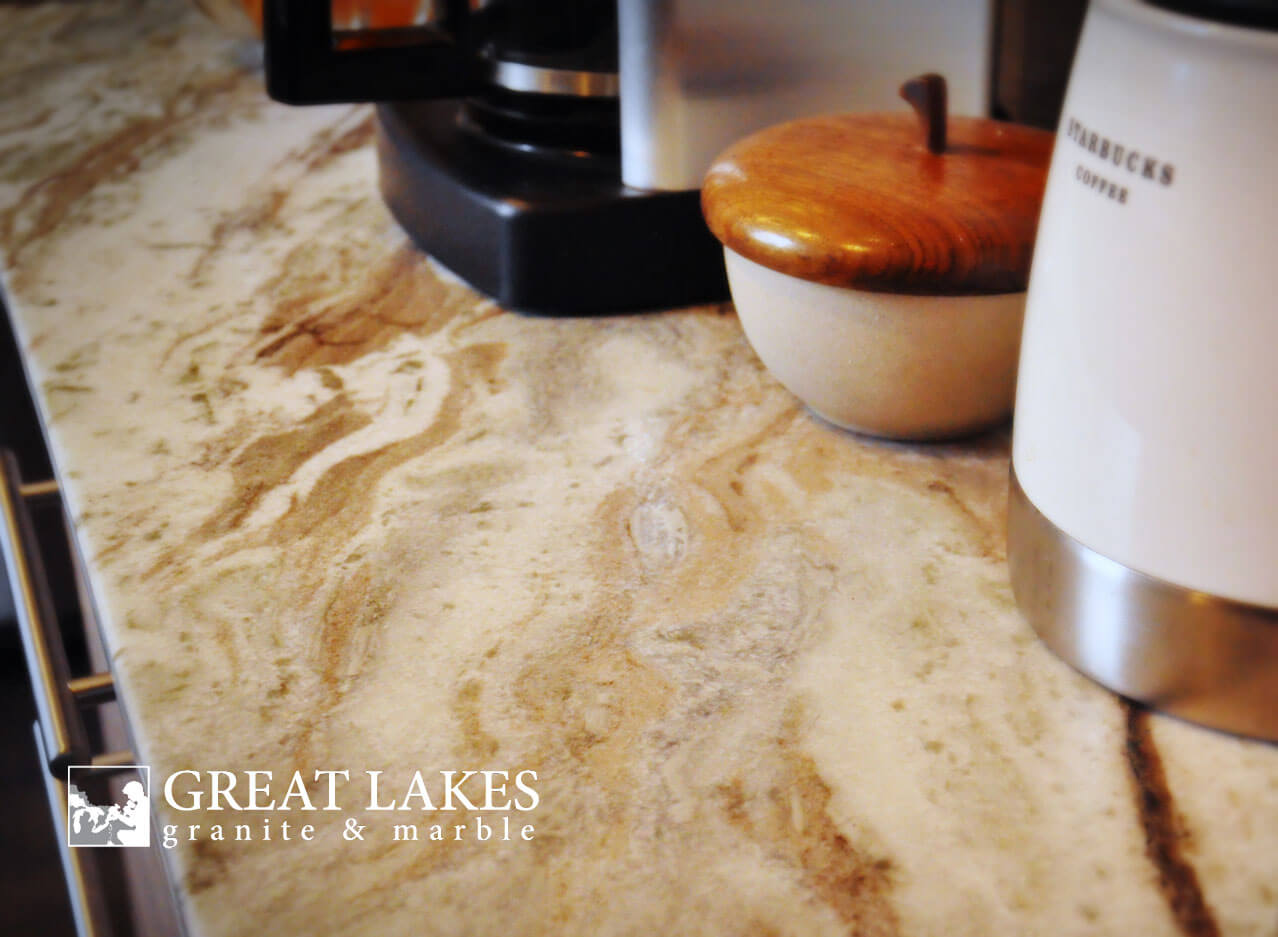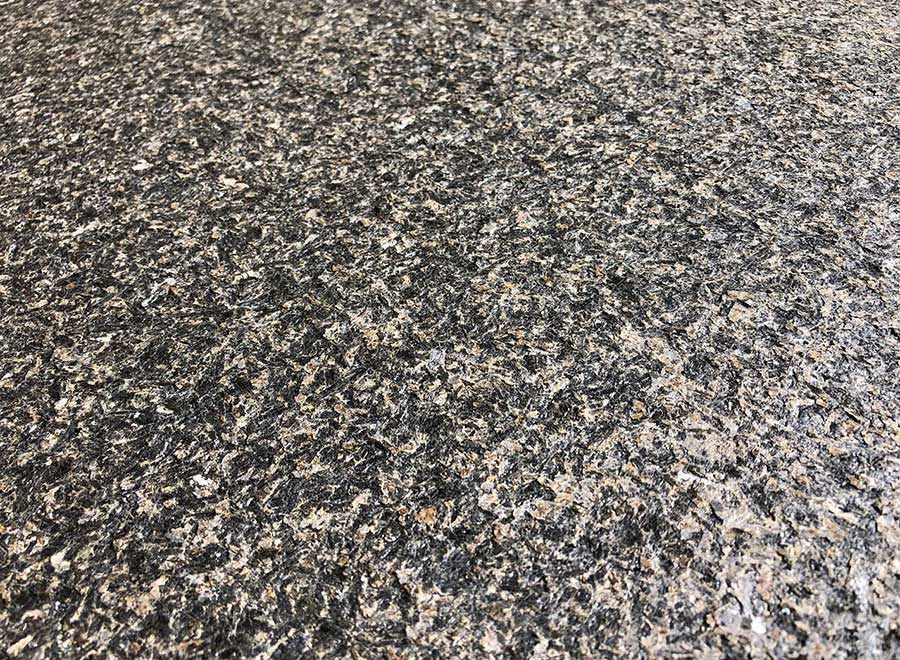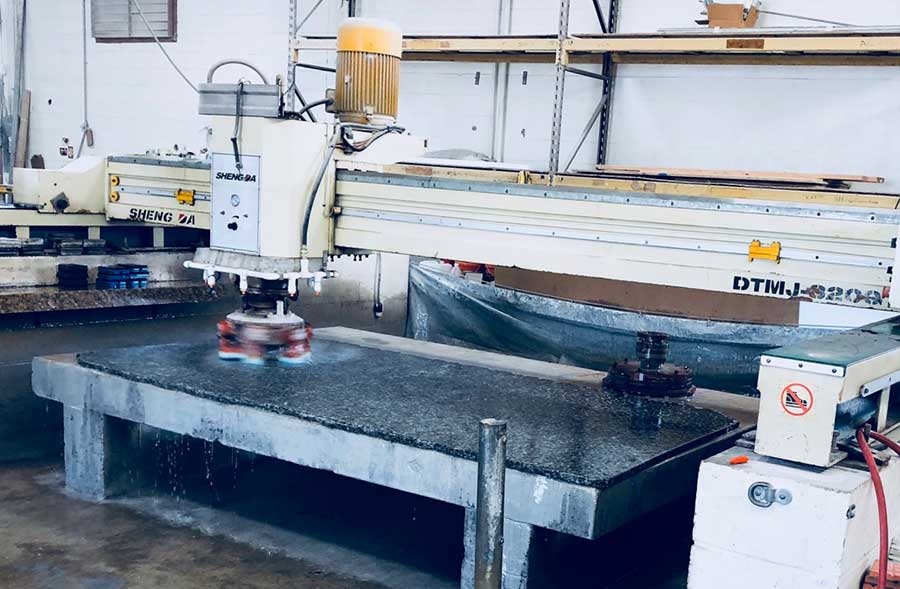When natural stone is quarried, the face of the stone is typically polished and although that may be the most common finish for countertops, there are plenty of other options. When you are evaluating stones, keep in mind that the appearance of the natural stone can be modified by the finishing process you select. Most natural stones can be finished with either a smooth or rough texture. Some projects lend themselves to a particular finish – for example a leathered look for a bar countertop. In this article, we will explore the different surface finishes and give you some pointers for choosing the one that best fits your needs and project.

Natural Stone Finishes
Countertop Finish Options for Natural Stone
There are close to 10 different finish options for natural stone. In this section, we will explore the different options, the finished look, common applications for that finish, and how it is achieved during fabrication.
| Finish | Granite/Quartzite | Marble | All Natural Stone |
| Polished | x | x | x |
| Honed | x | x | x |
| Leathered | x | x | |
| Flamed | x | ||
| Tumbled | x | x | |
| Bush Hammered | x | ||
| Sandblasted | x | x | x |
| Sawn | x | x | x |
Polished Finish
The first and most common finish is polished. Most stones come from the quarry with a polished face. When you picture a granite countertop, you likely picture a polished finish, a classy, sophisticated look that reveals the stone’s natural beauty and adds elegance to your space. A polished finish has a glossy, mirror-like shine that reflects light and draws attention to the stone. This finish is best known for its ability to reveal the true color and character of the stone.
A polished finish would provide a smooth work surface. You can find polished finishes in any countertop application, as well as potentially in flooring in a more formal room.
A polished finish is achieved through a grinding and buffing polishing process leaving the stone with a sleek, slippery surface and high-gloss finish. The stone slab goes through a series of polishing wheels fitted with coarse to extremely abrasive pads. These pads apply pressure to the stone, grinding and buffing polishing the surface. The pads start at 50 grit, going up to 3,000 grit to achieve the final polished, high-gloss look.

Honed Finish
A honed finish presents a satin buffed or matte appearance. This finish would have less reflection and shine than the polished finish, creating a softer look. A honed finish can evoke a relaxed, casual vibe while still retaining high class and character of the elegant stone. This finish will not show the color and texture of the granite as well as the polished finish. If you are looking for a slightly muted appearance, you may want to use honed granite for countertops or backsplashes.
The surface is smooth and provides a good work surface for countertops. A honed finish will leave the surface less slippery than polished and may conceal flaws characteristics better since it does not have as high a reflection. A honed finish can also be good for flooring as it is less likely to show evidence of traffic patterns or wearing. A honed finish is still moisture resistant but not as resistant as a polished finish.
A honed finish is achieved through a grinding sanding process and leaves marble and granite with a satiny-smooth surface. We can create a honed finish by stopping the finishing polish described above under polished finishes before the stone surface becomes shiny and glossy. This is how we achieve the satin or matte appearance.
Leathered Finish
Leathered stone has a textured, pebbly surface with little pits and fissures – similar to the surface of a fine piece of leather. The texture will vary from piece to piece and some stones will have more pronounced leather finish than others. The overall effect is warm, inviting, and perhaps a little rustic. Even though leathered stone is not glossy or polished as has little to no shine, it typically has more depth than a honed finish. There is enough texture and sheen to show off the stone’s natural characteristics without having the higher maintenance of a mirror-finish. Typically a leathered finish will show less staining, scratches, smudges, and fingerprints. One potential drawback of this finish is that it does not have a smooth, even surface, and cleaning in the natural pits and fissures could require a bit more work.
A leathered finish is a great option for bar tops, fireplace covers, bathrooms, or even to top special tables. You may hear the term “brushed” finish, which is the same as leathered.
A leathered finish is achieved by first removing the polished face. The next step is to grind the surface with leathering brushes that apply high pressure to the surface, this is done with long-bristled brushes. These brushes tend to create small undulations in the surface that ultimately result in the leathered finish. This process, like most, is done with high pressure and under the constant flow of water.
Polished, Honed, and Leathered are the most common residential finishes, but there are a variety of additional finished that are more common to the commercial space and we will cover those now.

Flamed Finish
Flamed granite is a textured surface that is slightly bumpy. This process can also lighten the finish of the stone a few shades, creating a more natural, faded, lighter, appearance. The textured surface creates a non-slip surface ideal for outdoors. An ideal application for a flamed finish would be an outdoor kitchen, or exterior walls and pavers.
We achieve a flamed finish using an oxygen/acetylene torch and applying high-temperature exposure to the stone. This high heat causes the individual grains in the stone to burst and change color.

Tumbled Finish
With a tumbled finish, the edges of the stone are rough and chipped. This produced a weathered or distressed look. In some applications, this aged look may be just the charm you are looking for. The aged appearance also makes this an ideal finish for high traffic areas, or areas such as a bathroom where a smooth stone would be slippery when damp or wet. We often see a tumbled finish with small, modular floor pavers or even backsplash tiles.
This finish is achieved by putting the pieces into a tumbler (picture a drum cement mixer) and mixing them up until they are worn and chipped.
Bush Hammered Finish
A bush hammered surface has many different textures from fine to coarse, the finished product is a very bumpy surface with extreme or shallow grooves. We often see this used for walls or floors – both interior and exterior.
To achieve this finish, we use a finishing machine with pneumatic hammers to carve the surface.
Sandblasted Finish
There are varying degrees of a sandblasted finish from coarse to fine sandblast. A fine sandblasted finish is a darker finish where a coarse sandblasted finish is a lighter finish. Once sandblasted the stone is left with very small craters in the surface resulting in a silky, matte appearance. A sandblasted finish is popular for monument work, gravestones, and artwork.
For a sandblasted finish, a high pressure air gun with sand integrated into the air stream is used. The technician works in a certain area of the slab going back and forth until the desired look is achieved. The remainder of the stone – whether it is a slab, monument, or piece of artwork – is covered with a rubber mat to protect it while they work on a specific area.
Sawn Finish
This is a course, rough, non uniform finish. We don’t see this finish too often, it gives the stone a very natural, almost prehistoric appearance.
When natural stone is quarried, typically the block is slabbed and then the face of the slab is polished before it is even sent to the fabricator. However for a sawn finish, the block is cut into slabs with a gang saw, or a 3 meter saw, then the face is not polished it is left unfinished giving it that “sawn” look.
Since most slabs come from the quarry with a polished face, you may be questioning how we can achieve some of these other finishes once your stone is already at the fabricator. Some fabricators have a slab polishing machine which can take a polished face and hone or leather the face. Alternatively, the fabricator can take the sawn side of the slab (side opposite the face) and apply the desired finish to that side.
Durability and Maintenance Based on Finish
A polished finish seals or closes most of the pores on the stone surface, making it easiest to clean and helping to repels stains. A honed polish is smooth but more porous than polished, so it can be more susceptible to staining. With a more porous stone, strong colored food and drinks can leave stains leading to dark spots or discoloration, although this is not a common occurrence. Granite is generally very resistant to staining regardless of the finish. Marble stone is slightly more susceptible to staining and scratching. Visit another one of our education articles For more information on care and maintenance of natural stone countertops.

Conclusion
The finish you select may be dependant on the type of stone you’ve chosen for your project. Granite and Quartzite can accept any of the finishes we have discussed, yet Marble cannot stand up to all of the finishes. For other stones such as travertine, soapstone, limestone and others they may be even more limited as to the types of finishes they can accept. Man-made quartz can only receive a few different finishes from the factory so if you are using quartz and desire a special finish it would need to be ordered that way.
The finish you select for your stone can completely change the look and feel of your stone, and your home. There are no wrong choices, just personal preference. We hope this article helps you make the right choice for your project.
